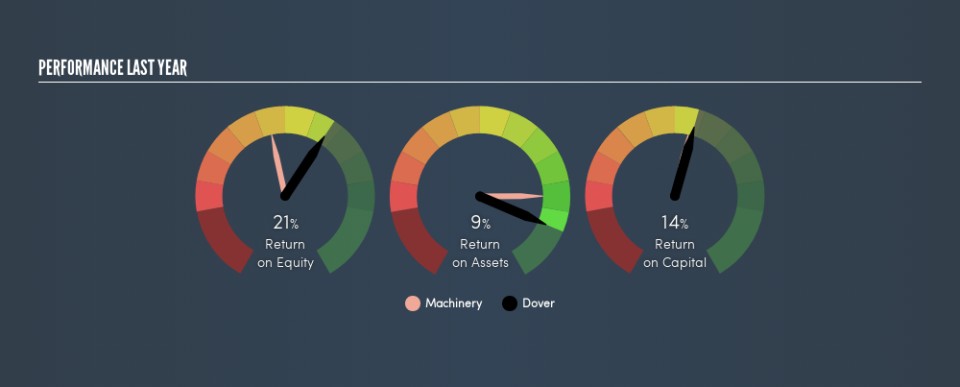What Can We Learn From Dover Corporation’s (NYSE:DOV) Investment Returns?

Today we’ll look at Dover Corporation (NYSE:DOV) and reflect on its potential as an investment. In particular, we’ll consider its Return On Capital Employed (ROCE), as that can give us insight into how profitably the company is able to employ capital in its business.
First of all, we’ll work out how to calculate ROCE. Next, we’ll compare it to others in its industry. And finally, we’ll look at how its current liabilities are impacting its ROCE.
Return On Capital Employed (ROCE): What is it?
ROCE is a measure of a company’s yearly pre-tax profit (its return), relative to the capital employed in the business. In general, businesses with a higher ROCE are usually better quality. Ultimately, it is a useful but imperfect metric. Author Edwin Whiting says to be careful when comparing the ROCE of different businesses, since ‘No two businesses are exactly alike.’
How Do You Calculate Return On Capital Employed?
Analysts use this formula to calculate return on capital employed:
Return on Capital Employed = Earnings Before Interest and Tax (EBIT) ÷ (Total Assets – Current Liabilities)
Or for Dover:
0.14 = US$907m ÷ (US$8.4b – US$1.8b) (Based on the trailing twelve months to December 2018.)
So, Dover has an ROCE of 14%.
See our latest analysis for Dover
Does Dover Have A Good ROCE?
ROCE can be useful when making comparisons, such as between similar companies. We can see Dover’s ROCE is around the 12% average reported by the Machinery industry. Separate from Dover’s performance relative to its industry, its ROCE in absolute terms looks satisfactory, and it may be worth researching in more depth.
It is important to remember that ROCE shows past performance, and is not necessarily predictive. Companies in cyclical industries can be difficult to understand using ROCE, as returns typically look high during boom times, and low during busts. ROCE is only a point-in-time measure. What happens in the future is pretty important for investors, so we have prepared a free report on analyst forecasts for Dover.
How Dover’s Current Liabilities Impact Its ROCE
Liabilities, such as supplier bills and bank overdrafts, are referred to as current liabilities if they need to be paid within 12 months. The ROCE equation subtracts current liabilities from capital employed, so a company with a lot of current liabilities appears to have less capital employed, and a higher ROCE than otherwise. To counteract this, we check if a company has high current liabilities, relative to its total assets.
Dover has total assets of US$8.4b and current liabilities of US$1.8b. As a result, its current liabilities are equal to approximately 22% of its total assets. A fairly low level of current liabilities is not influencing the ROCE too much.
Our Take On Dover’s ROCE
Overall, Dover has a decent ROCE and could be worthy of further research. You might be able to find a better buy than Dover. If you want a selection of possible winners, check out this free list of interesting companies that trade on a P/E below 20 (but have proven they can grow earnings).
If you like to buy stocks alongside management, then you might just love this free list of companies. (Hint: insiders have been buying them).
We aim to bring you long-term focused research analysis driven by fundamental data. Note that our analysis may not factor in the latest price-sensitive company announcements or qualitative material.
If you spot an error that warrants correction, please contact the editor at editorial-team@simplywallst.com. This article by Simply Wall St is general in nature. It does not constitute a recommendation to buy or sell any stock, and does not take account of your objectives, or your financial situation. Simply Wall St has no position in the stocks mentioned. Thank you for reading.

 Yahoo Finance
Yahoo Finance 
